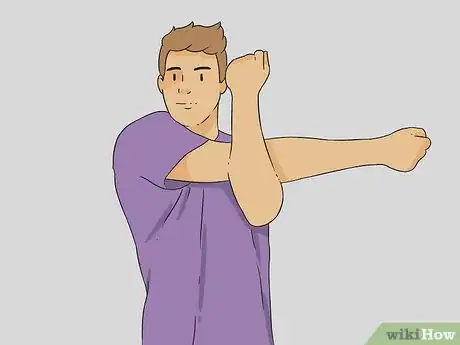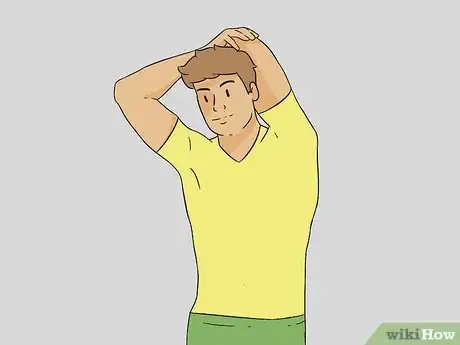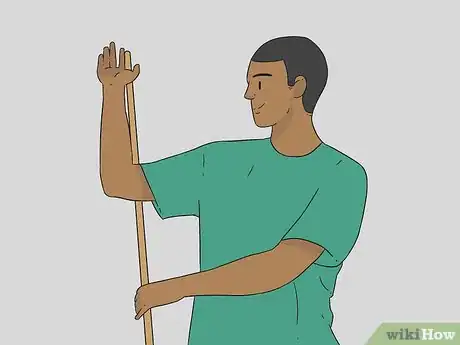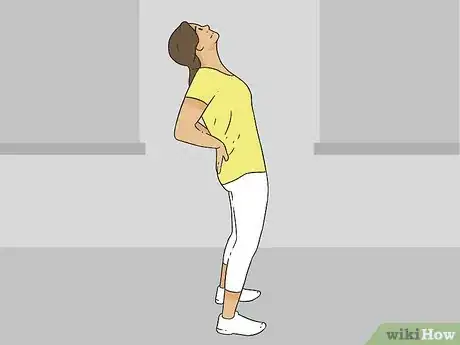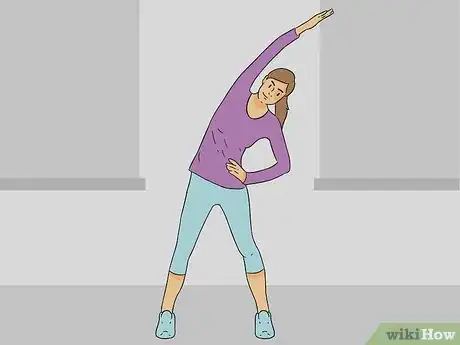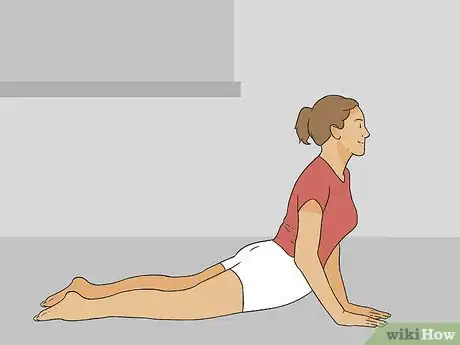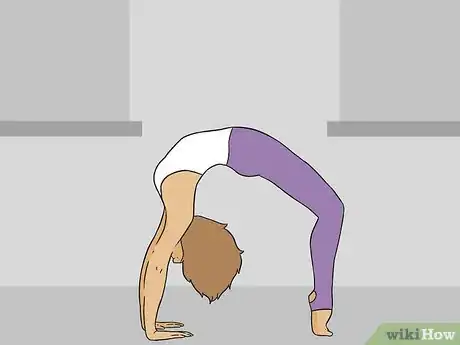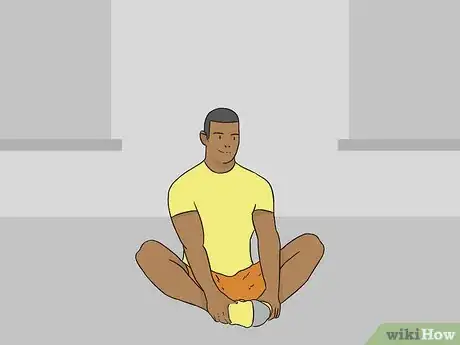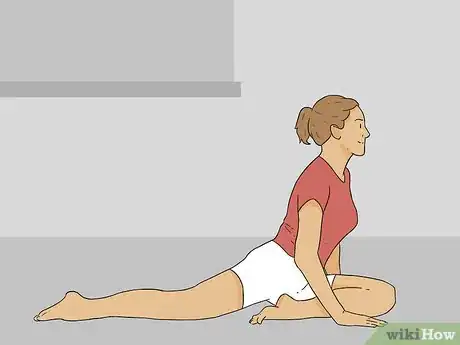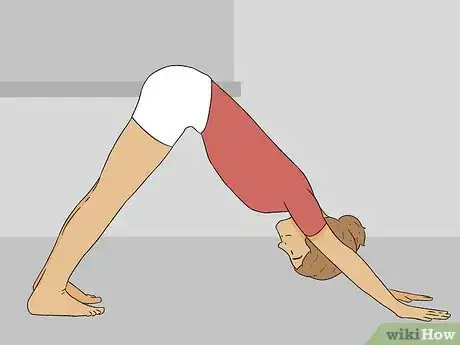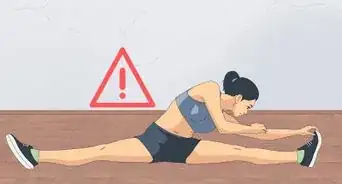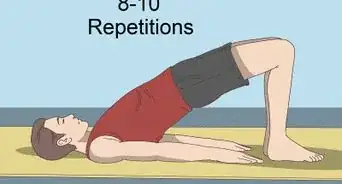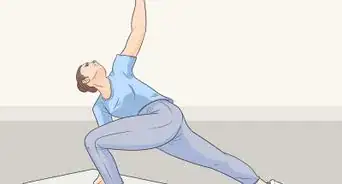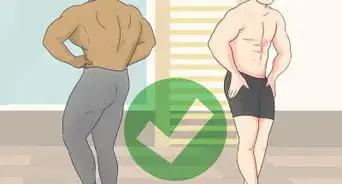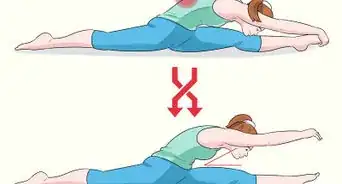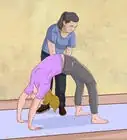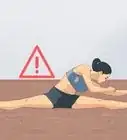This article was co-authored by Michele Dolan. Michele Dolan is a BCRPA certified Personal Trainer in British Columbia. She has been a personal trainer and fitness instructor since 2002.
There are 10 references cited in this article, which can be found at the bottom of the page.
wikiHow marks an article as reader-approved once it receives enough positive feedback. In this case, 85% of readers who voted found the article helpful, earning it our reader-approved status.
This article has been viewed 65,970 times.
Stretching before any form of exercise is crucial to increasing flexibility, avoiding injury, and reducing muscle soreness. Gymnastics, which uses almost every muscle in the body, requires extensive stretching before any activity. A thorough stretching routine that warms up the upper body, lower body, and core will help you perform your best and decrease your risk of injury in gymnastics.
Steps
Stretching Your Upper Body
-
1Pull 1 arm across your chest to stretch your shoulder. While standing, hold your right arm straight and use your left arm to pull it across your chest. Hold for 15 seconds, and switch arms. Repeat 4 times for each arm.[1]
-
2Put your palms behind your back and lift your arms to stretch your biceps. Stand with your feet about hip-width apart. Keep your arms and back as straight as possible while moving your hands up as far as they will comfortably reach behind your back, palms touching.[2]Advertisement
-
3Stretch your tricep by bending 1 elbow and pulling it behind your head. In a standing position, bend your right elbow, using your left hand to pull it gently behind your head. Hold for 15 seconds, then release and switch sides. Repeat this 4 times for each arm.[3]
-
4Do a rotator stretch with a broomstick. Stand up straight and put your right arm out to the side in an L shape with your right hand pointing up. Place a broomstick or other long stick behind your right arm and grab the end of it with your right hand. With your left hand, grab the bottom of the broomstick and use it to gently push your right elbow forward. Hold for about 30 seconds, then switch sides.[4]
-
5Use a doorway to stretch your pectoral muscles. Standing in a doorway or next to a wall, hold your right arm out to the side with your hand pointing upward. Press your arm against the wall on one side of the door and use the wall to gently push your right arm back. Hold for 15 seconds, then switch to your left arm. Repeat.[5]
Loosening Up Your Core
-
1Warm up your core by leaning backwards, using your hands as a brace. Place your feet about shoulder width apart with your toes turned slightly out, and put your hands flat against your lower back. Lean your upper body backwards, starting with your head, followed by your shoulders, then your back. Lean as far as you can, hold for a few seconds, then come back up. Do this about 10 times.[6]
-
2Reach 1 arm over your head and lean to 1 side to stretch your obliques. Standing with your left hand on your hip, reach your right hand over your head until your right arm touches your ear. Lean your upper body to the left, stretching your side. Hold for about 15 seconds, then switch sides. Repeat 3 times for each side.
-
3Loosen up your abs with a seal stretch. Lie down on your stomach and place your palms on the ground on either side of your ribs. Push up with your arms until your head is facing forward and your torso is fully lifted off the floor. Hold for 15 seconds. Repeat.[7]
-
4Do a bridge stretch to engage your back muscles. Lie down on the floor with your feet flat on the ground. Place your arms down along your sides. Gently lift your back up off the ground, starting with your hips. Hold for 15 seconds, then gradually come down, lowering your back gradually from top to bottom.
- If you are able, you can extend this stretch before you come down by doing a full backbend. Place your palms on either side of your head with fingers pointing toward your shoulders, then press down to lift your entire torso upwards in an arch shape.
Doing Lower Body Stretches
-
1Loosen up your adductor muscles with a butterfly stretch. Sit on the ground and press your heels together, using your hands to grasp your ankles and pull them gently towards you. Let your knees fall open as wide as they can, then gently press down on them with your hands to extend the stretch. Hold for 15 seconds, then bring your knees back together. Repeat 2-4 times.[8]
-
2Try a pigeon stretch to warm up your hips. Lie down on your back (preferably on a mat) with your legs straight. Grab your left ankle and place it on top of your right hip. Bend your right leg and use both hands to pull your right knee towards your chest. Hold for 15 seconds, then release and switch legs. Repeat once for each leg.
-
3Hold 1 foot behind you and bend forward to stretch your quads. Stand next to a table or counter you can use for balance, and grab your left foot behind you and pull it towards your hips. Lean your torso forward, keeping your right leg and back straight. Hold for 15 seconds, then release and switch legs.
-
4Stretch your hamstrings with a downward dog pose. Put your feet and hands on the ground to make an “A” shape with your body. While keeping your back and legs as straight as possible, focus on moving your hips toward the sky and your heels toward the ground.[9]
Expert Q&A
Did you know you can get expert answers for this article?
Unlock expert answers by supporting wikiHow
-
QuestionWhen you cannot do a back bend from standing up, is it safe to stretch for a full 40 minutes? What's the best way to work up to doing a back bend?
 Michele DolanMichele Dolan is a BCRPA certified Personal Trainer in British Columbia. She has been a personal trainer and fitness instructor since 2002.
Michele DolanMichele Dolan is a BCRPA certified Personal Trainer in British Columbia. She has been a personal trainer and fitness instructor since 2002.
Certified Fitness Trainer Stretching for 20 minutes at one session should be safe. Ask your coach or trainer for advice. Start by practicing bending backwards over the back of a couch/sofa or a big arm chair. That way, you won't hurt your head or neck when you go back. You can also practice bending backwards over a big exercise ball.
Stretching for 20 minutes at one session should be safe. Ask your coach or trainer for advice. Start by practicing bending backwards over the back of a couch/sofa or a big arm chair. That way, you won't hurt your head or neck when you go back. You can also practice bending backwards over a big exercise ball. -
QuestionHow do I remind myself to stretch more?
 Community AnswerWrite on a calendar/diary, set an alarm, set aside a certain time each day so you'll make it a habit (you will be more flexible in the evening, but stretching gently when you first wake up is good also). Maybe get a friend or parent to remind you daily.
Community AnswerWrite on a calendar/diary, set an alarm, set aside a certain time each day so you'll make it a habit (you will be more flexible in the evening, but stretching gently when you first wake up is good also). Maybe get a friend or parent to remind you daily. -
QuestionWhat do I do if I get sore from stretching?
 Community AnswerJust push past your limit a little bit and hold it till the pain goes away then do it again.
Community AnswerJust push past your limit a little bit and hold it till the pain goes away then do it again.
Warnings
- Do not attempt these stretches if you are not a trained gymnast. Doing any stretch improperly can result in injury. If you are interested in starting a new stretching routine, talk to a coach or trainer.⧼thumbs_response⧽
- Holding stretches for longer than 1 minute before exercise can actually decrease your range of motion. Once you've stretched as far as you can, you should only hold that pose for about 15-30 seconds.[10]⧼thumbs_response⧽
References
- ↑ https://www.physioadvisor.com.au/exercises/flexibility-muscles-2/deltoid/
- ↑ http://www.fitday.com/fitness-articles/fitness/exercises/the-best-stretching-exercises-for-your-upper-arms.html
- ↑ http://www.physioroom.com/prevention/stretching4_3.php
- ↑ http://stretchcoach.com/articles/stretches-for-gymnastics/
- ↑ http://gocardinalsports.com/documents/2015/4/20//Stretching.pdf?id=617
- ↑ https://www.spine.org/KnowYourBack/Prevention/Exercise/StretchingFlexibility.aspx
- ↑ https://www.yogajournal.com/videos/salute-the-sun
- ↑ https://www.acefitness.org/education-and-resources/lifestyle/exercise-library/216/seated-butterfly-stretch
- ↑ https://www.fitnessmagazine.com/workout/stretch/hamstring-stretches/?page=7
